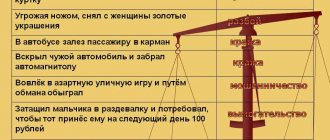Many people have at least a general understanding of criminal and administrative offenses and know that punishments for such atrocities vary. One day I was walking home after work and was attacked by a man with a knife. I was wearing a gold chain and a wedding ring.
The criminal took the gold and the bag. I contacted the police immediately, and managed to catch this man very quickly. Some questions arose during the investigation. At first, the officers qualified the crime as robbery, but then the prosecutor demanded a review, and as a result, the person was given a measure of responsibility under Article 162 of the Criminal Code of the Russian Federation “Robbery.”
This article will tell you what the difference is between robbery and robbery , what definition of each type of crime is given in the legal sphere, and where to go for help in such circumstances. We will separately consider the measures of responsibility established for perpetrators for crimes committed.
Robbery. Violent robbery
According to the first part of Article 161 of the Criminal Code of the Russian Federation, robbery is the open theft of someone else's property. Violent robbery is robbery with the use of violence that is not dangerous to life and health. The Plenum of the Supreme Court of the Russian Federation supplemented this definition, and according to Resolution No. 29, violence that does not pose a danger to life and health is considered:
- Causing minor harm to health , which did not entail consequences or entailed easily passing consequences, leaving traces that are visible for no longer than six days.
- Temporary deprivation or restriction of the victim’s freedom , if these actions were committed in order to freely take property.
- Mental violence is an indication of the threat of violence or the threat of violence that clearly does not pose a danger to human life and health.
Organization and methods of investigation
In the investigation of these criminal acts, their forensic characteristics are important - this is a set of data that allows one to properly conduct an investigation and work out investigative theories.
Theft by robbery and robbery pose the greatest danger to society, since they are committed with the use of violent actions, dangerous and not life-threatening. When committing these criminal acts, a person carries out a number of preparatory measures:
- exploration of the crime scene;
- studying the future victim;
- preparation of weapons and methods of execution;
- organizing methods of approach and departure (involving accomplices for help, preparing a vehicle, etc.);
- preparing the place where the stolen property will be stored;
- sales places.
When investigating these property crimes, it is necessary first of all to study the place where the theft took place. There it is also necessary to look for traces that could have remained from the kidnapper, subject to careful examination. Therefore, one of the main investigative measures is to inspect the scene of the theft, where any traces of the attacker can be found, including biological ones (fingerprints, traces of shoes, clothing, personal items, cigarette butts). All discovered items must be properly removed from the scene and entered into the protocol. After which the traces must be examined to find the possible thief or his accomplices.
It is also necessary to study the identity of the victim from whom the circumstances of the crime are being clarified. For the investigation, the victim’s method of movement and routes will be important, as well as the circle of people with whom the victim communicated (acquaintances, colleagues, neighbors). This will also make it possible to determine the circle of persons possibly involved in the theft.
Many crimes against property are solved without any delay, when the attacker did not have time to hide from the investigative authorities in a pre-prepared place and sell the stolen property.
Main differences
| Violent robbery | Robbery | |
| Danger to life and health. | Not dangerous to life and health | Dangerous to life and health. (Even potentially while committing a crime) |
| Threats | Threats of violence that are clearly not dangerous to life and health, but only if the victim realizes this. If a robber threatens with a fake pistol or other weapon, but the victim considers the threat to be real, then the crime can be classified as robbery. (According to the resolution of the RF PVS No. 29) | Threats of violence dangerous to life and health. |
| The moment from which the crime is considered completed. | When the criminal has a real opportunity to use the stolen property. | When the criminal begins to commit illegal actions (commits an attack). Because then the encroachment is primarily on the life and health of a person, and only then on his property. |
What is aiding
Resolution No. 29 regulates the concept of complicity. This aggravating circumstance may be present in both assault and robbery. When determining the circumstances of the incident, it is important to be able to distinguish the criminal from the accomplice. Eg:
- During an apartment robbery, a person picked the lock, but did not go inside and did not take part in collecting valuables. This person is a direct participant in the offense who is held accountable for an unlawful act committed in a criminal conspiracy.
- During the robbery of the apartment, there was a person who was not present at the theft and did not take part in it, but promised to help with the sale. Such a criminal is held accountable for complicity.
Download for viewing and printing:
Resolution No. 29 12/27/2002 On judicial practice in cases of theft, robbery and robbery
Violent robbery
Compound
- Object of the crime: property relations.
- The objective side of the crime: an attack with the use of violence that is not dangerous to life and health.
- Subject of the crime: a sane person at least 14 years old.
- The subjective side of the crime: direct selfish intent and motive. The goal is to openly seize someone else's property.
We examined the corpus delicti of robbery in more detail in a special material.
Example
A robber on the street tried to quickly take the girl’s purse, but she noticed this and tried to stop her. After which the criminal hit the girl on the arm, leaving light bruises, grabbed her purse and disappeared. This is violent robbery. If a robber on a deserted street approached and asked for money, and in response to refusal said that he could bruise his face (that is, this is an indication of a threat of violence, which is clearly not dangerous to health), then this is also a violent robbery.
We talk about what types of robbery can be qualified by law based on their crime elements here.
Responsibility
Paragraph d) of Part 2 of Article 161 of the Criminal Code of the Russian Federation states that robbery committed with the use of violence not dangerous to life and health, or with the threat of such violence, is punishable:
- Forced labor for up to five years.
- Imprisonment for no longer than seven years:
- with a fine of no more than 10,000 thousand rubles. or how much the convicted person earns (receives (unemployment benefits, pension, etc.)) in a month or less;
- without a fine and with restriction of freedom for no longer than one year;
- just no penalty.
Read what liability is provided for committing various types of robbery in a separate article.
Cases where there is no corpus delicti
In some cases, when the person seems to have all the signs of a crime, the behavior of the subject cannot be classified as a crime. Theft is no exception to this rule.
Here it is necessary to note such a concept as appropriation of a find (does not entail criminal liability). In this case, it is necessary to determine whether the item was lost or forgotten.
Important: a lost item is an item that does not have any identification signs of ownership and is located in a place that is unknown to the owner or possessor. In the case when a person lost his watch in the forest, it will become a find for someone else, but an abandoned car will not.
Robbery
Compound
- Object of crime: property relations, as well as human life and health.
- The objective side of the crime: an attack during which violence was used that was dangerous to the life and/or health of the victim, with the aim of stealing someone else’s property.
- Subject of the crime: a sane person at least 14 years old.
- The subjective side of the crime: direct selfish motive and intent. The goal is to steal someone else's property and cause harm to life and health as a means.
Example
Late in the evening, in a dark alley, a citizen crossed paths with a criminal, who, threatening with a pistol, forced him to give up all his valuables, then tied up the victim and left him on the road, where a car could drive by and run over the victim. This is robbery, and the criminal is not a robber, but a robber.
Responsibility
- Robbery is punishable (Criminal Code of the Russian Federation, Art. 162, Part 1):
- Forced labor for up to five years.
- Imprisonment for no longer than eight years: with a fine of no more than 500,000 thousand rubles. or how much the convicted person earns (receives) in three years or less;
- no penalty at all.
- Robbery committed by a group of persons by prior conspiracy, or with the use of weapons or objects used as weapons, is punishable (Criminal Code of the Russian Federation, Art. 162, Part 2):
- Imprisonment for no longer than ten years:
- with a fine of no more than a million rubles or how much the convicted person earns (receives) in five years or less;
- without a fine and with restriction of freedom for no longer than two years;
- no penalty.
- Robbery committed with illegal entry into a home, premises or other storage facility, or with the theft of a large sum of money, is punishable (Criminal Code of the Russian Federation, Article 162, Part 3):
- Imprisonment for a term of seven to twelve years:
with a fine of no more than one million rubles or how much the convicted person earns (receives) for five years or less; - without a fine and with restriction of freedom for no longer than two years;
- just no penalty.
- Robbery committed:
- An organized group.
- With the seizure of a particularly large sum of money.
- Injuring the health of the victim is punishable (Criminal Code of the Russian Federation, Article 162, Part 4): imprisonment for a term of eight to fifteen years: with a fine of no more than a million rubles or how much the convicted person earns (receives) in five years or less;
- without a fine and with restriction of freedom for no longer than two years;
- no penalty at all.
You can find out about the penalties for robbery committed by a group of persons by prior conspiracy in a special material.
Procedure for initiating a criminal case
To legally initiate a criminal case, the investigation needs to collect evidence confirming the presence of all elements of the crime. That is, there must be an object and an objective side, a subject with a subjective side. If at least one of the components is missing, the case cannot be sent for further investigation.
The subjects of the crimes under consideration are persons over 14 years of age. If we talk about theft and robbery, then in order to initiate a case it is necessary to prove that the desire to appropriate property arose before the implementation of the intentions. A thief must understand that he is encroaching on other people's property. For robbery, the very fact of the attack is important.
Criminal cases based on the offenses under consideration are initiated after the victim’s statement is received by the police. And they cannot be terminated by the investigator if the parties come to mutual agreement and reconcile.
Read more about the differences
- Danger to life and health is the indicator by which the distinction is made in the first place. If the violent methods used by the criminal at the time of the crime were dangerous, then even if life and health were not harmed as a result, this is robbery. If the harm caused by the criminal did not affect his ability to work, there were no consequences, or there were consequences, but they passed quickly enough, then this is violent robbery.
- Threats can be identified as a separate item, as mental violence.
According to the Criminal Code of the Russian Federation and Resolution of the PVS of the Russian Federation No. 29, if threats of violence pose a danger to life and health, then this is robbery, and if they clearly do not, then violent robbery. However, in practice it is difficult to determine where the line lies. The judge must decide this question, taking into account the place and time of the crime, the number of criminals, whether the victim had the opportunity to call for help, and also how real the threat seemed to him. If it was not life-threatening, but was perceived as such by the victim, then the crime is considered robbery, if the offender expected that the threat would be considered real. But if the actions of the criminal after such a threat indicate that he did not want to carry out the threat, then this is classified as violent robbery. - The end of the crime is the next point. The robbery is considered completed at the moment when the criminal can use the stolen property (read more about when a robbery is considered completed, read here). In the case of robbery, assault is considered a means of stealing property. The robbery is over the moment violence is committed, regardless of whether property was stolen as a result or not.
- Responsibility for robbery and non-violent robbery is also different.
Differences in penalties
The terms of forced labor for violent robbery and robbery are the same. But the term of imprisonment and the fine for robbery are longer. For robbery with aggravating circumstances, forced labor is not given, but the term of imprisonment and the fine increase.
Examples of judicial practice
The practice of courts regarding the punishment imposed on the accused is very ambiguous. The analysis shows that the more qualifying features in the committed act, the more serious the responsibility.
Sometimes it happens that a conviction occurs under several articles. This happens when an attacker damages someone else's item.
Below we give several examples of real sentences handed down by courts in the Russian region. Despite the different years, these decisions have not lost their practical significance.
Punishment for theft
The Karymsky District Court of the Trans-Baikal Territory found Ushakov guilty of burglary and gave him a suspended sentence with a probationary period of 2 years. This is confirmed by the verdict in case No. 1-114/2020 dated April 29, 2020.
Circumstances of the crime. Ushakov, being drunk, decided to steal property from the victim’s apartment. To do this, he broke a window and climbed into the closet, from there, breaking the lock, he entered the victim’s apartment. After which he took the electric kettle and disappeared in an unknown direction.
The defendant admitted his guilt, had no previous convictions, and there was also a mitigating circumstance such as Ushakov’s state of health. As a result, he was given only a suspended sentence.
Robbery
The Kirovsky District Court of Kemerovo, by its verdict in case No. 1-283/2017 dated December 1, 2017, found Kite guilty of robbery and set a sentence of 2 years and 4 months in prison.
The collected evidence established that Kite asked the victim for a cell phone to make a call, but had no intention of returning it and, contrary to the victim’s requests, fled with the stolen property.
The accused was previously convicted, but fully admitted his guilt and assisted in the investigation. In this regard, the court sentenced him to imprisonment for 1 year and 6 months. But due to the remaining unserved previous sentence, he extended the sentence to 2 years and 4 months.
Robbery
Rozum committed four episodes of robbery at once. To do this, he used a knife, which was later recognized by experts as a bladed weapon.
The investigation established that the accused went into cafes and grocery stores in the evening and, showing the saleswomen a knife, demanded to give him all the money from the cash registers, sometimes taking away alcohol or cigarettes. All victims perceived his threat as real and feared for their own lives.
During the investigation, the defendant fully admitted his guilt and actively contributed to the detection of all crimes. Based on these circumstances, the Prikubansky District Court of Krasnodar found Rozum guilty of committing four crimes under Part 2 of Art. 162 of the Criminal Code of the Russian Federation and imposed a total of four years in prison.
Peculiarities of theft qualification: excess of the perpetrator
The excess of the perpetrator is understood as the commission by the perpetrator of a criminal act that was not covered by the intent of other attackers.
Example. A group of young people under 18 years of age, with the goal of enriching themselves at someone else’s expense, attacked their peers not far from the school. In their arsenal, the group of attackers had metal pipes with which they threatened to cause physical harm in order to take away the money. One of the teenagers refused to give the money voluntarily, so one of the attackers invited the others to beat him. He was refused this offer, after which he hit him in the head with a metal pipe. The victim fell from the impact, and the injury was not compatible with life.
The qualification of criminal acts of a group corresponds to robbery under Part 2 – by a group of persons. However, in this situation the excess of the performer is evident , since the group did not have a single intent to cause serious harm to health.
You can study in more detail the question of how robbery differs from robbery in the Resolution of the Plenum of the Supreme Court.










